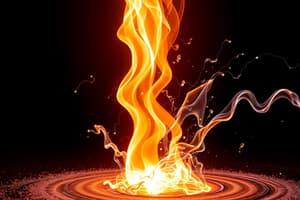Podcast
Questions and Answers
What does the law of conservation of energy state?
What does the law of conservation of energy state?
How is work related to energy?
How is work related to energy?
Which unit is considered the standard unit of energy?
Which unit is considered the standard unit of energy?
What characterizes a closed system in terms of energy?
What characterizes a closed system in terms of energy?
Signup and view all the answers
In an isolated system, which of the following is true?
In an isolated system, which of the following is true?
Signup and view all the answers
What is the formula for kinetic energy?
What is the formula for kinetic energy?
Signup and view all the answers
How does kinetic energy depend on mass and velocity?
How does kinetic energy depend on mass and velocity?
Signup and view all the answers
Which of the following is an example of potential energy?
Which of the following is an example of potential energy?
Signup and view all the answers
What is the primary characteristic of thermal energy?
What is the primary characteristic of thermal energy?
Signup and view all the answers
What is meant by energy conservation?
What is meant by energy conservation?
Signup and view all the answers
What is the unit of power?
What is the unit of power?
Signup and view all the answers
Which type of energy is released during chemical reactions?
Which type of energy is released during chemical reactions?
Signup and view all the answers
What happens to energy during a transformation?
What happens to energy during a transformation?
Signup and view all the answers
Study Notes
Introduction to Energy in Physics
- Energy is the capacity to do work.
- It exists in various forms, including kinetic, potential, thermal, chemical, electromagnetic, nuclear, and others.
- Energy is conserved, meaning it cannot be created or destroyed, only transformed from one form to another.
- The total energy of an isolated system remains constant.
Kinetic Energy
- Kinetic energy (KE) is the energy of motion.
- It depends on an object's mass and velocity.
- The formula for kinetic energy is KE = 1/2 * m * v^2, where 'm' is mass and 'v' is velocity.
- Greater mass or velocity results in higher kinetic energy.
- Kinetic energy is a scalar quantity, meaning it only has magnitude, not direction.
Potential Energy
- Potential energy (PE) is stored energy that depends on an object's position or configuration.
- Common types include gravitational potential energy and elastic potential energy.
- Gravitational potential energy is related to an object's height above a reference point.
- Elastic potential energy is stored in objects that can be stretched or compressed, like a spring.
- The formula for gravitational potential energy is PE = m * g * h, where 'm' is mass, 'g' is acceleration due to gravity, and 'h' is height.
Forms of Energy
- Thermal Energy: The energy associated with the random motion of particles within a substance.
- Chemical Energy: Stored in the bonds between atoms in molecules. Released in chemical reactions, like combustion.
- Electromagnetic Energy: Travels as waves; includes light, radio waves, microwaves.
- Nuclear Energy: Stored in the nucleus of an atom. Released in nuclear reactions, like fission and fusion.
- Sound Energy: Mechanical energy transmitted as waves through a medium, commonly air.
Energy Transformations
- Energy can be transformed from one form to another.
- Examples include:
- Mechanical energy transforming into heat due to friction.
- Chemical energy in fuel transforming into kinetic energy in a car.
- Solar energy transforming into electrical energy in a solar panel.
- The efficiency of a transformation is typically less than 100%, with some energy often lost as heat.
Power
- Power is the rate at which work is done or energy is transferred.
- It is measured in watts (W), which is joules per second (J/s).
- The formula for power is Power = Work / Time or Power = Energy / Time.
- Higher power means a faster rate of energy transfer.
Conservation of Energy
- The law of conservation of energy states that energy cannot be created or destroyed, only transformed from one form to another.
- This principle applies to all physical processes.
- The total energy in a closed system remains constant.
Energy and Work
- Work is done when a force causes displacement. The work done is measured as the product of the force and the parallel displacement.
- This is conceptually related to the concept of energy, as work done changes the energy of an object. Therefore, work can be viewed as the transfer of energy.
Units of Energy
- The standard unit of energy is the joule (J).
Energy and Systems
- The total energy in a system is the sum of all the energies within the system (kinetic, potential, thermal, etc.).
- In closed systems, energy is conserved.
- Energy is often exchanged between systems through work and heat.
Types of Energy Systems
- Isolated Systems: No energy or mass exchange with surroundings
- Closed Systems: No mass exchange, energy exchange possible
- Open Systems: Both mass and energy exchanged with surroundings.
Studying That Suits You
Use AI to generate personalized quizzes and flashcards to suit your learning preferences.
Description
This quiz covers the fundamental concepts of energy in physics, including kinetic and potential energy. It explores the different forms of energy, the principle of conservation of energy, and mathematical formulas associated with kinetic energy. Test your understanding of these essential topics.




